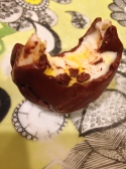Fluffy the Vegan Unicorn here:
Being that I am an ethereal being, who only wants to best for everyone, animals, and humans alike, I am here to share why human rights are important for vegans to think about and make food decisions based around in addition to animal rights. I implore you to treat humans as compassionately as you do animals. Humans are animals too, and deserving of peace and protection. Making excuses as to why human beings do not deserve fair treatment, such as some humans’ having the capacity for evil, will not challenge or end any suffering. Try to think of the essence and energy of me, a beautiful, positive unicorn who loves everybody and can spread love everywhere the next time you want to turn away from making a decision that will be good for the rights of both humans and animals.
Now I am sending some of that energy over to Laura, who will share some basic information on human rights and her favorite vegan resources doing powerful work for the vegan movement that also happen to include human rights in their missions.
Laura says:
Human rights are an expansive concept. To gain an understanding of what is generally understood to be considered universal human rights, check out the UN’s Declaration of Human Rights here. Though these rights have been declared and adopted by the UN, they are constantly being violated around the world and in the United States.
I want to try to keep this to food-related human rights issues since vegan MoFo stands for Month of Food, but know that I’m happy to have more comprehensive discussions the comprehensive subject of human rights more with others.
Food justice, cultural awareness, racism, classism, ableism, health, ethnocentrism, are just a few of the topics we should be aware of when we have conversations about veganism and making it a more inclusive movement.
As a social justice-minded white person, I want to lift up, value, and listen to the voices of people of color, women and people who are trans or gender non-conforming, people with disabilities and chronic illnesses (different than my own), people of different religions, and socioeconomic statuses when they say white vegans need to recognize their privilege and consider their criticisms about how the general vegan movement has failed to consider or be sensitive to their struggles and needs.
I believe that as a white person I need to educate myself about human rights and social justice, racism, and beyond, not rely on asking others who have experienced injustices to tell me how it is. It is not their responsibility and can contribute to further oppression.
So, I feel it is best, at this point, to share some of the resources, blogs, websites, books, etc. I have found helpful in educating myself. I hope if you are like me, that these resources open your eyes to others’ struggles in the vegan community and beyond and inspire you to take action towards justice. If you are a person who has experienced oppression from vegans in regards to your race/sex/gender/disability/class/etc. that some of these resources will be encouraging if you have not seen them yet.
These are just a small handful, but anyone is welcome to share more of these in the comments.
Food Empowerment Project. Website: http://www.foodispower.org/
F.E.P is a nonprofit vegan food justice organization. They seek to educate vegans about human rights issues present in chocolate, bananas, coffee, and more. They are behind an extensive amount of research on chocolate companies and whether they violate human rights (of children especially) and started a list of vegan chocolate lists they would recommend or not recommend based on their research. The list is on their website and also available as a searchable smartphone app.
Just as importantly, Food Empowerment Project addresses farm workers rights, food insecurity and lack of access to healthy foods in their community, provides delicious recipes for vegan Mexican food, and so much more. Their website is available in both Spanish and English.
Decolonize Your Diet. Website: http://decolonizeyourdiet.org/
This is a resource designed for and by Latinos/as with the purpose to reclaim their food choices to honor their ancestors who were colonized. They share recipes, information about food ingredients, herbs and tea, cooking techniques, health, and more. They have published a cookbook and have an index of their recipes on their website. When you visit the site, be sure to click on “kindred spirits” where they share other people and organizations in line with their mission.
Sistah Vegan Project. Website: http://www.sistahvegan.com/
Dr. A. Breeze Harper has lots of information on her website, in her books, on social media, in podcasts, and elsewhere about her own experiences being a black, feminist, vegan, scholar. Her book Sistah Vegan highlighted her own and other women of color’s experiences. It is considered a must-read.
Vegan Feminist Network. Website: http://veganfeministnetwork.com/
Vegan Feminist Network has a wealth of information on vegan intersectional feminism. Their website is a source for essays on almost any topic you can think of and beyond. They have comprehensive resources for all kinds of issues, including tips for understanding racism and sexism, for male allies, reading lists, and more. I especially like their page titled “What You Can Do!” They are also on social media and have a podcast.
*
So please check them all out and educate yourself on the importance of honoring human rights! Hopefully, the more of us that become aware of these issues, the less this perception of vegans not caring about humans will be true.
I’ve been a little overwhelmed by writing these last two posts, but I hope that they are useful to you and have stimulated some thoughts. It is now time I get started cooking my dinner tonight, which I hope will be successful and that I can share with you tomorrow to smash the misconception that vegan cheese is not real cheese!






























